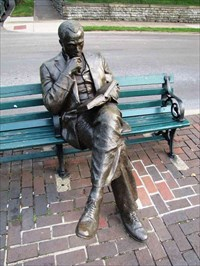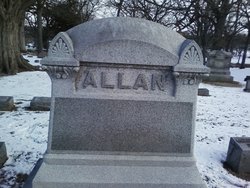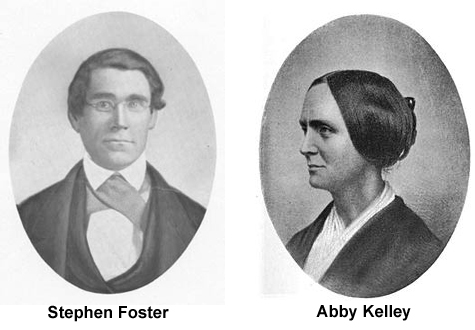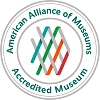Lucy Stone and the Margaret Garner tragedy
Saturday, September 21st, 2013by Ron Gorman, Oberlin Heritage Center volunteer docent
The winter of 1856 was a particularly harsh one – harsh enough that the Ohio River froze solid in January, something that only happened every few years. When it did happen, enslaved Americans on the Kentucky side of the river would take the opportunity to make their break for freedom across the solid ice. January 1856 saw two freedom seekers cross the frozen Ohio who would eventually make national headlines. They were unknown to each other, and crossed at different places with different groups, but both would have an Oberlin connection. One of their stories would have a happy ending; the other would be one of the most tragic stories of American slavery.
The story with the happy ending belonged to John Price, of Oberlin-Wellington Rescue fame, who crossed the Ohio River on horseback at Maysville, Kentucky. But this blog post is about the tragic story, belonging to Margaret Garner, who crossed fifty miles downriver at Cincinnati. The Oberlin connection in her story is through Oberlin College graduate Lucy Stone. However, Stone’s role was sadly not as a rescuer, but instead as a consoler, as two women from vastly different backgrounds came face-to-face in a grim chapter of American history.
Lucy Stone had come to Oberlin from Massachusetts in 1843 and enrolled in the general program at Oberlin College, pursuing a Bachelor’s degree. She was 24 years old and already an avid follower of William Lloyd Garrison and his radical abolitionist/feminist/pacifist “no government” views. She was immediately impressed with Oberlin, writing “The teachers are pleasant, and the young ladies too. Colored gentlemen and ladies eat at the same table with us, and there appears to be no difference.”
As progressive as Oberlin was, in one area it was still quite conservative, much to Stone’s frustration. The general nationwide tabboo against women speaking in public was quite evident at Oberlin, prompting her to say, “I hoped when I came to Oberlin that the course of study would permit such practice, but I was never in a place where women are so rigidly taught that they must not speak in public.” But Stone was a natural orator, with tremendous charisma, persuasiveness and logical power, and “the voice of an angel” that could yet project enough to be heard by thousands. And she would not be silenced. She helped resurrect the Young Ladies’ Assocation on campus and led many spirited debates there. She also engaged in ad hoc speeches and debates whenever she could, sometimes enduring the disapproval of much (but not all) of the faculty, and greatly honing her already exceptional oratory skills. In one debate with an older male student, her opponent later confessed that she “swept [my arguments] away like chaff before the wind.”
When she wasn’t debating or studying, she earned spare money by teaching classes to fugitive slaves and freedmen. Initially there was some discontent among the male students at having a female teacher, but Stone quickly overcame the objections and became quite popular with the students. Not only did she teach them, but she learned from them as well, listening empathetically to their stories of life in slavery. She wrote, “When I saw how they were dehumanized… I wondered, that in the wide universe of god, one tongue could be found, that failed to utter its indignant rebuke against all that pertains to so execrable a system.”
She also wrote numerous articles and became the Oberlin correspondent for the Anti-Slavery Bugle, a radical anti-slavery newspaper published in Lisbon, Ohio. Her articles were sometimes critical of Oberlin for being too conservative (as ironic as that may sound), preferring the much more radical brand of abolitionism espoused by Garrison and his Boston followers (see my William Lloyd Garrison and Frederick Douglass debate in Oberlin blog post for more information.) Her career at Oberlin was thus a love-hate relationship, culminating in her 1847 graduation with a Bachelor’s degree.
After graduating she returned to Massachusetts and became a paid lecturer for the New England Anti-Slavery Society. Her lectures were exceedingly popular, albeit controversial because of both the abolitionist topic and the gender of the speaker. She found herself speaking more and more on behalf of women’s rights, sponsoring her own lectures and drawing large crowds of paying guests. Her lectures took her all over the country, including even some Southern states, and to Canada as well. Then, in 1855, she married a Cincinnati businessman named Henry Blackwell, in a ceremony in which the couple issued a protest against the traditional subservient role of the wife. By mutual agreement, Stone kept her own surname – the first woman in the country to do so.
Then, just nine months after the wedding, the shocking news of the Margaret Garner story broke nationwide. Stone was on a speaking tour in the Northeast when Margaret Garner crossed the frozen Ohio River on foot with a party of 16 other freedom seekers. Margaret Garner was just 22 years old, but already was married and had four children and was pregnant with a fifth. When her party reached the Ohio shore they split up into smaller groups and went in different directions. Margaret’s group of eight included her husband and children. They made their way to the residence of a freed slave who they knew by the name of Elijah Kite.
Kite, being concerned about the safety of his guests, went to consult with Cincinnati’s foremost Underground Railroad conductor, Levi Coffin. Coffin advised that the Garner party be moved “at once” to an African American settlement on the western side of the city where freedom seekers often took refuge. Kite returned to his home to get the Garners, while Coffin made arrangements for their transportation northward that night.
But while all this was going on, Garner’s owner, Archibald Gaines, had crossed the Ohio River and gathered a posse of slavecatchers in pursuit. They interviewed people who had seen the Garner party on the road and were able to track them to Kite’s residence. Kite had not had time to remove the Garner’s before his dwelling was surrounded by the slavecatchers, who demanded that they surrender. Levi Coffin described what happened next:
“The fugitives were determined to fight, and to die, rather than to be taken back to slavery. Margaret, the mother of the four children, declared that she would kill herself and her children before she would return to bondage. The slave men were armed and fought bravely. The window was first battered down with a stick of wood, and one of the deputy marshals attempted to enter, but a pistol shot from within made a flesh wound on his arm and caused him to abandon the attempt. The pursuers then battered down the door with some timber and rushed in. The husband of Margaret fired several shots, and wounded one of the officers, but was soon overpowered and dragged out of the house. At this moment, Maragert Garner, seeing that their hopes of freedom were vain, seized a butcher knife that lay on the table, and with one stroke cut the throat of her little daughter, whom she probably loved the best. She then attempted to take the life of the other children and to kill herself, but she was overpowered and hampered before she could complete her desperate work. The whole party was then arrested and lodged in jail.”

Artist’s (incorrect) depiction of the Margaret Garner tragedy
The party remained in jail for almost a month while the legal wrangling continued. They had numerous visitors, but according to Coffin, “those who came to speak words of comfort and cheer felt them die upon their lips, when they looked into [Margaret’s] face, and marked its expression of settled despair. Her sorrow was beyond reach of any words of encouragement and consolation, and can be realized in all its fullness only by those who have tasted of a cup equally bitter.” Visitors noticed two old scars on Margaret’s face, but when asked about them she would only reply, “white man struck me.” Others noticed the light complexion of her children and speculated that it was evidence of sexual abuse at the hands of her owner.
One of the visitors who tried to console Margaret was Lucy Stone, who returned to her new home in Cincinnati after completing her speaking tour. While Stone met with Margaret, a rumor started that Stone had attempted to procure a knife for Margaret so she could finish the job if the trial went against her. The slaveholder’s attorney, Colonel Chambers, openly accused Stone of this in court. When Stone heard about the accusation, she asked to be allowed to address the court after it adjourned for the day. At that time, speaking with her natural eloquence, Lucy Stone Blackwell (as the court called her) made the following statement to a packed courtroom:
“I am only sorry that I was not in when Colonel Chambers said what he did about me, and my giving a knife to Margaret. When I saw that poor fugitive, took her toil-hardened hand in mine, and read in her face deep suffering and an ardent longing for freedom, I could not help bid her be of good cheer. I told her that a thousand hearts were aching for her, and that they were glad one child of hers was safe with the angels. Her only reply was a look of deep despair, of anguish such as no words can speak.
I thought the spirit she manifested was the same with that of our ancestors to whom we had erected the monument at Bunker Hill–the spirit that would rather let us all go back to God than back to slavery. The faded faces of the negro children tell too plainly to what degradation female slaves must submit. Rather than give her little daughter to that life, she killed it. If in her deep maternal love she felt the impulse to send her child back to God, to save it from coming woe, who shall say she had no right to do so? That desire had its root in the deepest and holiest feelings of our nature–implanted alike in black and white by our common Father. With my own teeth I would tear open my veins and let the earth drink my blood, rather than to wear the chains of slavery. How then could I blame her for wishing her child to find freedom with God and the angels, where no chains are?
I know not whether this Commissioner has children, else I would appeal to him to know how he would feel to have them torn from him, but I feel that he will not disregard the Book which says: ‘Thou shalt not deliver unto his master the servant which is escaped from his master unto thee: he shall dwell with thee, even among you, in that place which he shall choose in one of thy gates, where it liketh him best.'”
Listening to Stone speak was a reporter from the women’s rights newpaper, The Lily, who was enthralled with “the fascinating power of her voice, so irresistibly sweet and powerful. Its melody has lingered around my heart ever since I first heard its tones, like a magic spell, and I only wish that it might reach the ear of the nation – when I am sure its stubborn heart would relent.”
But the stubborn heart of the nation did not relent. The Fugitive Slave Law reigned supreme. The Garners had top-notch legal counsel in the person of the abolitionist attorney, John Jolliffe, and support from the newly inaugurated abolitionist Governor of Ohio, Salmon Chase. But it wouldn’t be enough. Jolliffe argued that the Garners had, in prior years, been brought into Ohio by their owner on business, and that under Ohio law that made them free, even though they had not realized it at the time. The court agreed that they would have been free at that time, if only they had claimed their freedom. But since they “voluntarily” returned to Kentucky and slavery with their owner, they had surrendered that freedom. And now, being in Ohio as fugitives without their owner’s consent, they were subject to be returned to his custody.
Then Jolliffe tried an extremely unusual maneuver. He asked the county prosecutor to indict his own clients for the murder of Margaret’s two year old daughter, believing that a conviction would bring them out of federal custody and into state custody where Governor Chase could pardon them. But the court would have no part of it. The Fugitive Slave Law superseded even Ohio’s murder laws. To the “outrage” of Governor Chase, a U.S. district judge ordered the Garners released to the slavecatchers, and “hardly an hour elapsed… before the fugitives were lodged in a Kentucky jail.” Governor Chase issued a warrant of extradition, but the slavecatchers eluded his agents, and the Garners were sold “downriver” to what attorney Jolliffe called “the seething hell of American slavery.”
But fate would intervene on the boat ride down the Mississippi, as the boat was involved in a collision and Margaret Garner and one of her children ended up overboard. The child drowned, but Margaret was pulled back aboard the ship. Some claimed that Margaret “displayed frantic joy” when told of the death of her child. Margaret herself would survive to make it to New Orleans, but would die there of typhoid fever two years later. The Underground Railroad, which helped tens of thousands of freedom seekers escape from bondage, had been unable to help Margaret Garner. Like her two children, and millions of other enslaved Americans before her, death was Margaret Garner’s rescuer.
Margaret Garner’s story became the inspiration for Lorain native Toni Morrison’s Pulitzer Prize winning novel, Beloved. The novel, and a series of park benches she placed in “important locations in African American history” around the world, are dedicated to the memory of the slaves. One of those benches is in Oberlin’s Toni Morrison Park on the northeast corner of Lorain and Main Streets. (Click for video, courtesy Visit Lorain County).
Sources consulted:
Levi Coffin, Reminiscences of Levi Coffin
Andrea Moore Kerr, Lucy Stone: Speaking Out for Equality
Jacob William Shuckers, William Maxwell Evarts, The Life and Public Services of Salmon Portland Chase
Mark Reinhardt, Who Speaks for Margaret Garner?
“Bench by the Road Project”, The Toni Morrison Society
Robert Samuel Fletcher, A history of Oberlin College: from its foundation through the Civil War, Volume 1
















